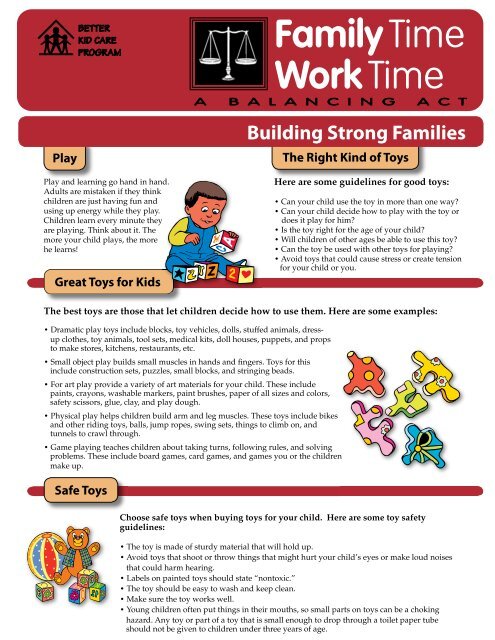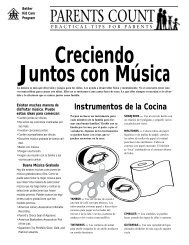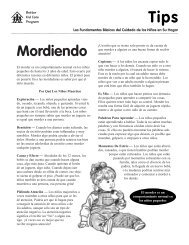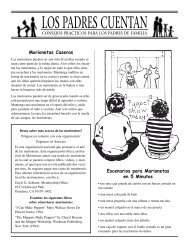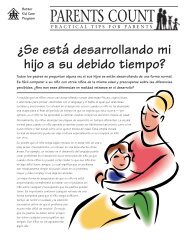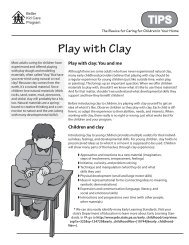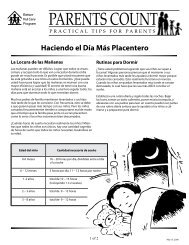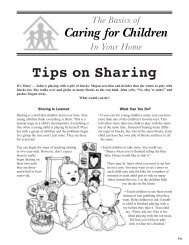November - Better Kid Care - Penn State University
November - Better Kid Care - Penn State University
November - Better Kid Care - Penn State University
Create successful ePaper yourself
Turn your PDF publications into a flip-book with our unique Google optimized e-Paper software.
Play<br />
Play and learning go hand in hand. d.<br />
Adults are mistaken if they think<br />
children are just having fun and<br />
using up energy while they play.<br />
Children learn every minute they<br />
are playing. Think about it. The<br />
more your child plays, the more<br />
he learns!<br />
Great Toys for <strong>Kid</strong>s<br />
• Dramatic play toys include blocks, toy vehicles, dolls, stuffed animals, dressup<br />
clothes, toy animals, tool sets, medical kits, doll houses, puppets, and props<br />
to make stores, kitchens, restaurants, etc.<br />
• Small object play builds small muscles in hands and fingers. Toys for this<br />
include construction sets, puzzles, small blocks, and stringing beads.<br />
• For art play provide a variety of art materials for your child. These include<br />
paints, crayons, washable markers, paint brushes, paper of all sizes and colors,<br />
safety scissors, glue, clay, and play dough.<br />
• Physical play helps children build arm and leg muscles. These toys include bikes<br />
and other riding toys, balls, jump ropes, swing sets, things to climb on, and<br />
tunnels to crawl through.<br />
• Game playing teaches children about taking turns, following rules, and solving<br />
problems. These include board games, card games, and games you or the children n<br />
make up.<br />
Safe Toys<br />
Building Strong Families<br />
The Right Kind of Toys<br />
Here are some guidelines for good toys:<br />
• Can your child use the toy in more than one way?<br />
• Can your child decide how to play with the toy or<br />
does it play for him?<br />
• Is the toy right for the age of your child?<br />
• Will children of other ages be able to use this toy?<br />
• Can the toy be used with other toys for playing?<br />
• Avoid toys that could cause stress or create tension<br />
for your child or you.<br />
The best toys are those that let children decide how to use them. Here are some examples:<br />
Choose safe toys when buying toys for your child. Here are some toy safety<br />
guidelines:<br />
• The toy is made of sturdy material that will hold up.<br />
• Avoid toys that shoot or throw things that might hurt your child’s eyes or make loud noises<br />
that could harm hearing.<br />
• Labels on painted toys should state “nontoxic.”<br />
• The toy should be easy to wash and keep clean.<br />
• Make sure the toy works well.<br />
• Young children often put things in their mouths, so small parts on toys can be a choking<br />
hazard. Any toy or part of a toy that is small enough to drop through a toilet paper tube<br />
should not be given to children under three years of age.
Some Toys to Avoid<br />
Avoid toys that play for the child, such as those that talk, sing, or dance when a button is pushed; toys that teach<br />
violence such war toys, action figures from violent television shows, balls made to look like bombs, or toys from<br />
horror shows or movies; toys linked to television programs, movies, music, and video games for teens and adults;<br />
toys linked to advertising candy or unhealthy foods.<br />
Make Your Own Toys<br />
There have been many toy recalls lately. Think about making some toys for your child. Choose<br />
safe materials to make them and you can be sure your child’s toys are safe!<br />
Homemade blocks - Blocks can be made from boxes of various sizes. You can also use clean cardboard milk containers<br />
by cutting off the tops and putting the open ends inside each other. Use duct tape to secure them. These make sturdy<br />
blocks. For variety, use round snack containers for cylinder shapes. There are tall ones and shorter ones. You can cover<br />
homemade blocks with newspaper, construction paper, colored contact paper, or leave them plain. If you cover them<br />
with paper, secure the paper with tape.<br />
Shakers - Use empty water bottles to make shakers. Put some me rice or dried beans<br />
inside the bottle. Hot glue the lid to the bottle to make sure it will not open.<br />
Puppets - Puppets can be made from paper plates, paper lunch unch bags, wooden craft<br />
sticks, or socks. Young children can have hours of fun pretending ending with a puppet<br />
friend.<br />
Puzzles - Cut the front side off a cereal box. Use a non-toxic c marker<br />
to draw different sized interlocking shapes. Cut these<br />
out. Glue them to a piece of cardboard to make them sturdier er or<br />
cover with clear contact paper.<br />
Sock bags - Children love to throw things. Instead of using<br />
bean bags, roll up a pair of socks to make a sock bag for your ur<br />
child to throw into a<br />
basket or a box.<br />
Bowling game - Save empty water bottles and use them as<br />
bowling pins. Have your child line them up on the floor andd<br />
arrange them in rows for bowling. Give your child a ball to<br />
roll to knock down the pins.<br />
Pre-K Counts in <strong>Penn</strong>sylvania<br />
Parents in <strong>Penn</strong>sylvania need to be aware that the PA Pre-K Counts programs offer free half-day and full-day quality<br />
pre-kindergarten programs throughout the Commonwealth of <strong>Penn</strong>sylvania. Pre-K Counts is a state initiative administered<br />
by the PA Department of Education that provides 11,000 three- and four-year-old children throughout the<br />
state a high quality early learning experience. Criteria for enrollment include family income levels (300% of the federal<br />
poverty level or a family of four earning $61,500), language (English is not the first language), and cultural or special<br />
needs issues.<br />
You may be eligible to apply. For a complete list of programs offering the Pre-K Counts programs in <strong>Penn</strong>sylvania, go<br />
to the PA Department of Education Web site at www.pde.state.pa.us and click on the Pre K-12 section. From the list on<br />
the left side of the Web page, click on Early Childhood and then click on <strong>Penn</strong>sylvania Pre-K Counts on the left side.<br />
Family Time/Work Time: <strong>November</strong> 2007<br />
Dr. James E. Van Horn, <strong>Better</strong> <strong>Kid</strong> <strong>Care</strong> Program Director<br />
Supported by funds from the <strong>Penn</strong>sylvania Department of Public Welfare, Office of<br />
Child Development and Early Learning. Developed by the <strong>Better</strong> <strong>Kid</strong> <strong>Care</strong> Program.<br />
253 Easterly Parkway, <strong>State</strong> College, PA; Phone 1-800-452-9108.<br />
Website: www.betterkidcare.psu.edu.<br />
College of Agricultural Sciences<br />
Cooperative Extension<br />
Developed by:<br />
Nancy Wilson, <strong>Penn</strong> <strong>State</strong> <strong>Better</strong> <strong>Kid</strong> <strong>Care</strong> Program, <strong>Penn</strong> <strong>State</strong> <strong>University</strong><br />
Resouces: Lyn Horning, Choosing Toys Children Really Like, from The Basics of Caring<br />
for Children in Your Home Tips, <strong>Better</strong> <strong>Kid</strong> <strong>Care</strong> Program, <strong>Penn</strong> <strong>State</strong> <strong>University</strong>; Kelly<br />
Swanson, September 2007, Communications, and Public Policy Director, PA Pre-K Counts<br />
Program<br />
This publication is available in alternative media on request.<br />
<strong>Penn</strong> <strong>State</strong> is committed to affirmative action, equal opportunity,<br />
and the diversity of its work force.<br />
Copyright © 2007 The <strong>Penn</strong>sylvania <strong>State</strong> <strong>University</strong>


